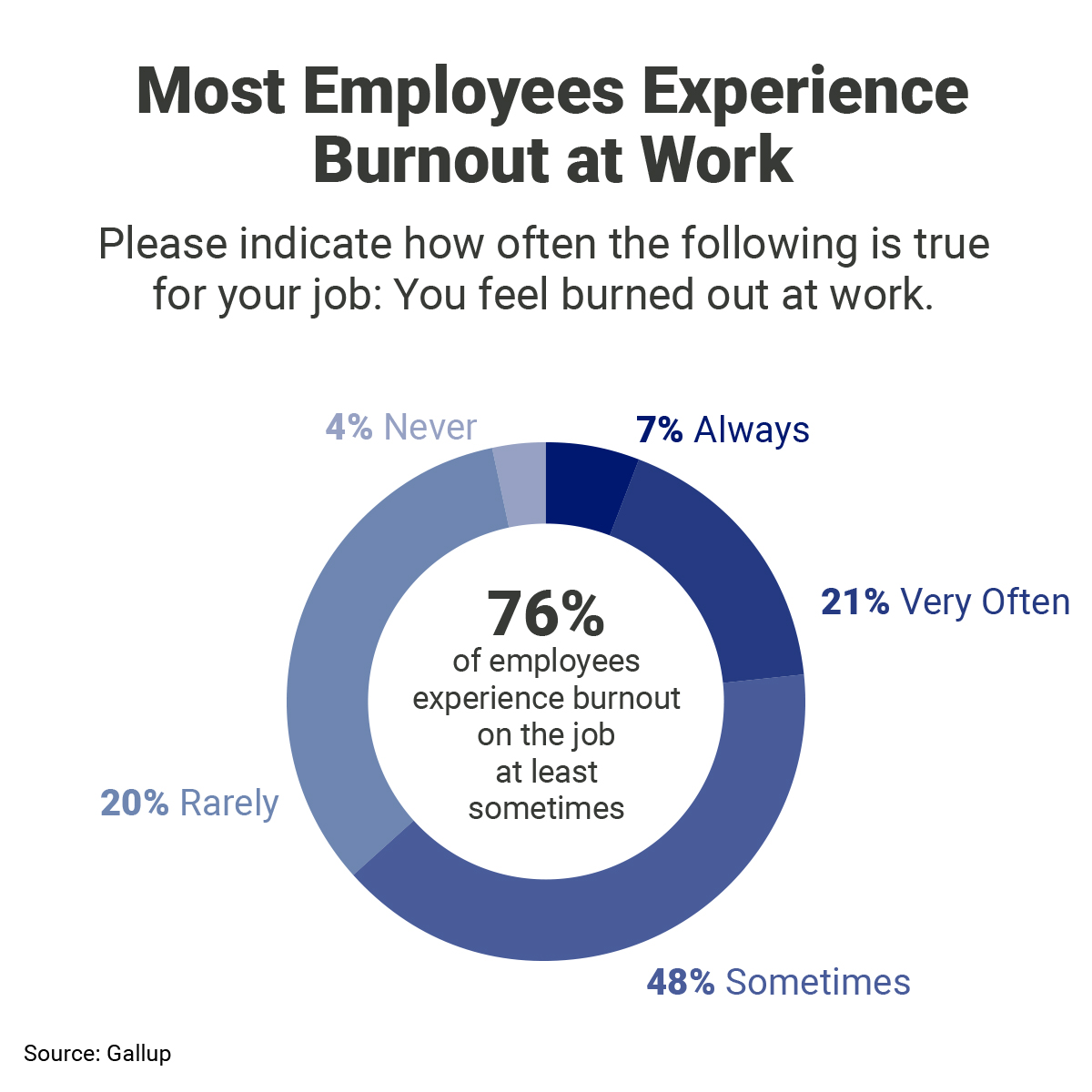
We Need to Talk About Employee Burnout in the Public Sector
Health, Workforce Transformation, CivilianIt's no secret that after two years of a global pandemic, workers of all types are tired, stressed, and burnt out—which, in many instances, can derail morale and innovation. This may be especially true within the federal government, where many workers have been on the frontline of not just the COVID-19 pandemic, but also natural disasters, political unrest, and the challenging, everyday work of running the country.
Many are faced with policies, funding cycles and systems that aren’t set up to be flexible. Government agencies responded quickly to the pandemic, leveraging technology to enable employees to work remotely, as well as instituting changes to processes and responsibilities where necessary. However, the reality is that many employees worked longer hours, missed the down time when transitioning from onsite work to home, and found themselves growing tired from being in Zoom meetings all day. Now, as more federal agencies are considering significant and permanent changes to their working arrangements, including hybrid work and flex-scheduling, it's time to consider ways to limit burnout in this next transition.

Employee burnout doesn't just impact individuals. Workplace fatigue can raise attrition levels, absenteeism, and the potential for human error in skilled work—all issues that can become very costly financially and culturally over time. A recent study from cybersecurity firm Forcepoint showed that employee burnout also leads to an increased risk for security errors, including shortcuts like using personal devices to access secure content because it’s easier in the moment. The cumulative effect of these issues can put stress on entire teams, diminishing workplace interactions and mission outcomes for the agency or organization themselves.
LMI experts outline ways that the federal government can begin to counteract the challenges of the pandemic and mitigate burnout.

Build Resilience into Teams
Agencies and organizations within the federal government have robust hierarchies of management and reporting, which should be leveraged to build resilience into teams.
At the highest level, building resilience is about fostering a culture of open and honest bidirectional communication, engagement, and modeling. This includes building a culture that is not defined by perfection—leaders should encourage employees to share ideas without repercussion or judgment and express their emotions openly. Leaders should also be clear about what they expect and when they expect it. According to a recent Gallup survey, one of the leading causes of employee burnout was unclear communication from leadership about expectations.
Resilient communication styles involve more than just interoffice memos or quick emails. Leadership needs to enable and empower the supervisors on their teams, giving them training and toolkits to help them understand how communicating and engaging the workforce in a virtual or hybrid realm is different. It’s not just about two-way communication. Leadership should be willing and able to interact directly with managers, team leads, and employees on an individual basis to discuss feedback, using multiple modes of communication.
“A leader who is committed to building a resilient and adaptable team will openly share priorities with the team, explain what the team’s role is in helping meet those priorities, and offer a forum for the team to share feedback and ideas about resources and support the team may need. When employees feel connected to the mission, they are less likely to feel burned out because they know their work is valued and their leader is open to implementing changes to enhance their experience,” says Wendy Myers, director for human capital solutions at LMI.
Karla Finger, an LMI senior consultant and resiliency expert, coaches individuals and teams on how to become more resilient. She explains that developing resilience is a personal journey. “People do not all react the same to traumatic and stressful life events. An approach to building resilience that works for one person might not work for another. Leaders can demonstrate and encourage employees to adopt behaviors and mindsets that strengthen resilience. For example, resilient people approach challenging situations as opportunities for learning and self-discovery; they engage in self-care and activities that promote mental wellbeing and physical health; they cultivate a broad network of personal and professional relationships to create a strong base of support; and they maintain a mindset by understanding what is and is not in their control and choose to focus on what is in their control. Finally, resilient leaders have compassion for themselves and others.”
Leverage Tools and Technology
Many agencies are currently looking at return-to-work plans. Employees across the public and private sectors are pushing for greater flexibility in scheduling as well as hybrid work. This creates incentive for federal agencies to examine and modernize their policies and procedures and implement technologies that support remote work on a more permanent basis.
Modernizing tools and technology can lead to gains in productivity, and organizations, agencies, and firms may realize facility-related cost savings. Modernization can include providing updated technology that can support video conferencing or implementing collaboration tools that make it easier to conduct meetings and share information when employees are working remotely.
The past two years have also provided battle-tested best practices within teams. Many teams changed how often they meet, how they share information, or how they delegate responsibilities as they shifted to remote work. Some teams also built flexibility into when employees worked to allow for parents to handle their responsibilities while kids were at home. While those shifts may have been ad-hoc initially, if they are working well, formal policies may need to be updated to reflect current working arrangements. Ultimately, they may also be helpful when it comes to attracting and retaining new talent, especially within minority populations. In the Gallup survey, employees noted that they were more inclined to stay with or join teams that had flexible work policies in place.
Shaye Brotherton, a solutions architect at LMI, notes that increasing flexibility can also be a talent retention and attraction tool. “The war for talent is real, and flexibility in the workplace is increasingly important to the broader workforce. Employers will be challenged to successfully compete in attracting and retaining talent critical to their future, if they are not willing to adapt while competitors offer roles with that flexibility built in.”
Use Success Cases to Drive Policy
The federal government is currently considering several packages of legislation that would codify rules around remote work for federal employees. This is an opportunity for policymakers to reach out to agencies and organizations and listen to what has worked for them.
All legislation currently up for consideration includes calls for the creation of agency metrics and key performance indicators (KPIs) to track the performance of remote work and in-person work. The data for those metrics may already exist. By reaching out to agencies before rules are created, policymakers and other stakeholders will gain visibility into what agencies are already doing and where improvements can be made.
The past two years have shown that managing burnout is both an individual and team effort. When work happens at home the lines between both worlds can get blurry. Employees need to feel empowered to manage their time and voice when expectations are unclear or unrealistic. Managers can support employees by embedding flexibility into workflows and listening to feedback about expectations and priorities. Agencies and organizations that are in the process of defining policies going forward can engage resiliency experts to help craft flexible policies and provide training on how to build resilience into teams. Teams that do this well tend to be more stable in times of stress and may also find they have a competitive advantage when it comes to attracting and retaining talent.
A productive workforce starts with supported employees. LMI has over 60 years of experience supporting government employees to feel and perform their best. If you're interested in personalized coaching services for you or your team, reach out to Janet Webb to discuss today.


Janet Webb
Vice President, Public HealthJanet Webb leads LMI’s health market, driving and delivering the latest technology across the evolving landscape of healthcare.


Shaye Brotherton
Sr. Principal, Management Advisory ServicesShaye Brotherton provides solution architect expertise across diverse LMI service lines, focusing on integration of disparate capabilities and innovation areas.


